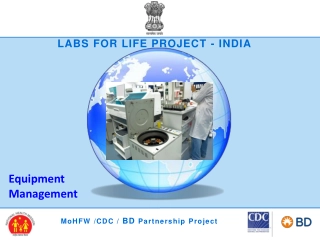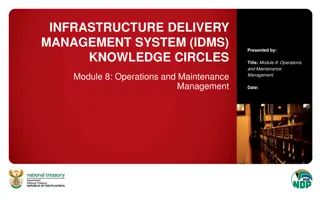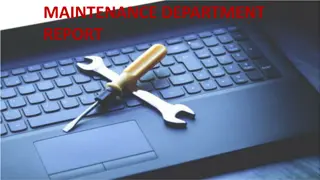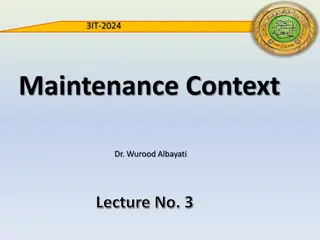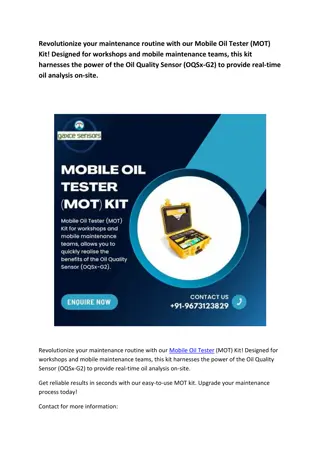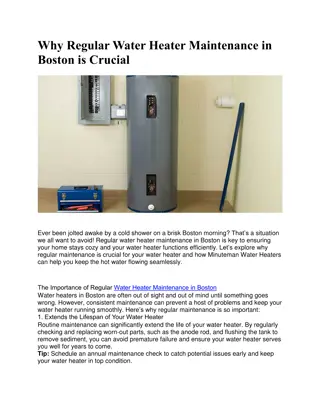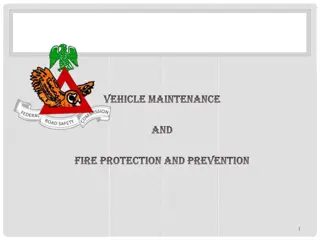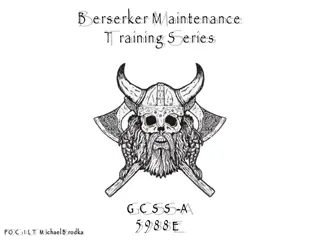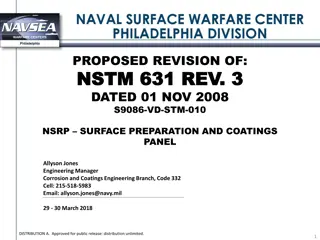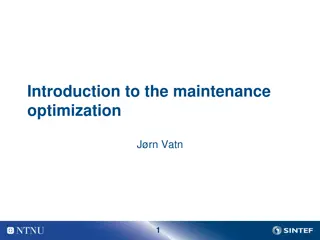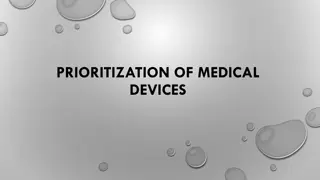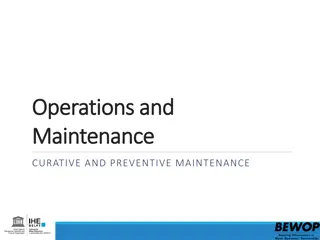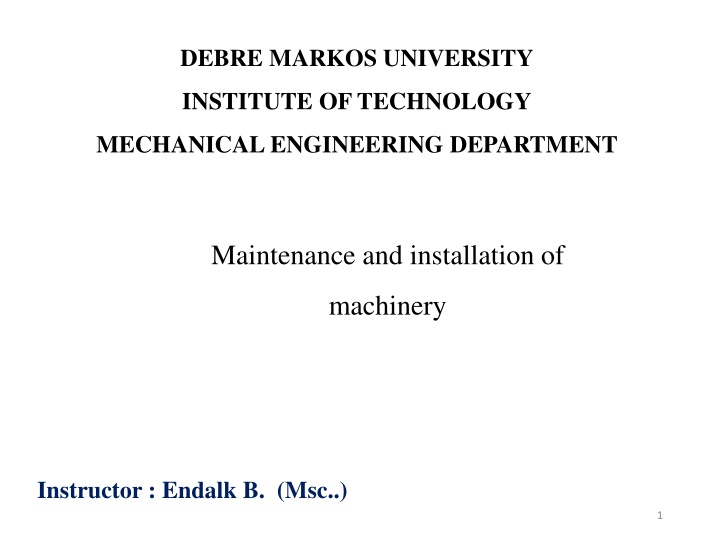
Maintenance and Installation of Machinery: Determination of State of Damage
Understanding the state of damage in machinery is crucial for effective maintenance routines and schedules. This article explores the methods and principles involved in determining the state of damage, both directly and indirectly, for optimal equipment performance and longevity.
Download Presentation

Please find below an Image/Link to download the presentation.
The content on the website is provided AS IS for your information and personal use only. It may not be sold, licensed, or shared on other websites without obtaining consent from the author. If you encounter any issues during the download, it is possible that the publisher has removed the file from their server.
You are allowed to download the files provided on this website for personal or commercial use, subject to the condition that they are used lawfully. All files are the property of their respective owners.
The content on the website is provided AS IS for your information and personal use only. It may not be sold, licensed, or shared on other websites without obtaining consent from the author.
E N D
Presentation Transcript
DEBRE MARKOS UNIVERSITY INSTITUTE OF TECHNOLOGY MECHANICAL ENGINEERING DEPARTMENT Maintenance and installation of machinery Instructor : Endalk B. (Msc..) 1
Chapter-4 4.1Determination of state of damage The state of damage of machinery is the undesired deviation from the required state fixed in the design procedures. For the phase of testing of new components or equipment (means of production), knowledge of the state of damage can be used for setting meaningful maintenance routines or schedule . The state of damage of equipment depends on:- Kind and condition of damage, and Duration of operation of equipment. 2
.....contd Determination of the state of damage is part of technical diagnostics and maintenance. Technical diagnostics is the determination of the technical state of damage of equipment, for collection of information and for deciding the state and kind of maintenance. This is normally done without disassembling while the equipment is in operation. 3
.....contd Conclusions arrived at about the state of damage of an equipment are probabilistic, and the accuracy of results obtained depends on the accuracy of the method of investigation used, sampling techniques. Hence, the usefulness of the results has to be evaluated carefully and decisions made have to be supported by experienced and good judgment. 5
4.2 Measuring values for the state of damage The measuring principles employed are two: a. Direct measured quantities, and b. Indirect measured quantities Direct measured quantities The direct measuring technique determines the difference between the initial state and the state after wear process. The measurement taken can be direct linear, volumetric or mass quantities 6
...contd These measured quantities can be absolute or related to duration of operation. Absolute measurement gives the amount wear as an average worn out thickness. Related measurement gives amount of wear per unit time of operation Direct measurement is usually done after disassembly. But it can also be made without disassembling provided there is easy access to the measured quantities. 7
Indirect measuring quantities During the operation of a machine or parts of it, certain signals are produced which are related to the state of operation of the machine. These signal, which are known as the diagnostic parameters; if properly analyzed provide some information regarding the state of the machine. It should be noted that influence from the environment introduces errors in the measured results. 8
4.3 Methods of condition monitoring Most techniques of condition monitoring amount to the systematic application of commonly accepted methods of fault diagnosis. These techniques are classified as on-load or off-load monitoring techniques. On-load monitoring techniques On-load monitoring techniques are mostly carried out without interruption of operation of the unit. 9
.....contd These techniques include: Visual, aural and tactical inspection of accessible components; Temperature monitoring. Lubricant monitoring. Leak detection. Vibration monitoring/sound monitoring. Corrosion monitoring. 10
Off-load monitoring techniques Off-load monitoring techniques require shutdown of one unit. These include: Crack detection; Visual, aural and tangible inspection of normally inaccessible or moving parts; Leak detection; Vibration testing; Corrosion monitoring 11
4.4 Condition monitoring techniques Most failures give some warning before they occur. This warning is called potential failure. Potential failure is defined as an identifiable physical condition which indicates that a functional failure is either about to occur or it is in the process of occurring; A functional failure is defined as the inability of equipment in meeting a specified performance standard. 12
Potential failures and on-condition maintenance:- If evidence can be found that some component/equipment is in the final stage of failure, it may be possible to take action to prevent complete failure and/or its consequences. The P-F curve is employed to show what happens in the final stages of failures:- point where failure start to occur point where we can determine that component is falling (potential failure) point where component has failure (functional failure) time 13
The P-F curve shows:- Where failure in the equipment starts to occurs: Where equipment condition going to the point at which the failure can be detected; and finally, Where the equipment has failed indicating functional failure. Fig. P-F curve 14
....contd The P-F interval:- is the interval between the occurrence of a potential failure and its deterioration in to functional failure. The P-F interval is the warning period, or the lead time to failure, or the failure development period. Fig. P-F interval curve 15
.....contd Between points P and F it may be possible to take action to prevent functional failure or to avoid consequences of functional failure. Tasks designed to detect potential failures are known as on- condition tasks. On - condition tasks bring about checking for potential failures so that action can be taken to prevent functional failure or to avoid the consequences of the functional failure. This is known as predictive maintenance or condition-based maintenance. 16
.....contd The longer the P-F interval for inspection more time to take appropriate actions to avoid the consequence of failure. Small deviation from the normal requires sensitive monitoring techniques and equipment. It can be concluded that the P-F curve is an important tool-in determining the condition monitoring techniques and setting the equipment for conducting the monitoring task. 17
4.5 Categories of condition monitoring techniques Condition monitoring techniques are designed to detect specific symptoms which are related to the state of damage of the equipment. The monitoring techniques are classified according to the symptoms monitored. Dynamic monitoring Detects potential failures which cause emissions of abnormal energy in the form of waves such as vibration and noise. Equipment which contain moving parts that vibrate are monitored dynamically. 18
.......contd There are various techniques that belong to this category, Broad band vibration analysis (changes in vibration characteristics are monitored) Constant bandwidth analysis (changes in vibration characteristics are monitored by using accelerometers) Real time analysis (measurement of vibrational signals; shock analysis) Ultrasonic analysis (changes in sound pattern are monitored) 19
Particle monitoring Particle monitoring detects potential failures which cause particles of different sizes and shapes to be released in to the environment in which the component is operating. These include wear particles and corrosion particles; Examples Real time ferromagnetic sensors Graded filtration Sedimentation 20
Chemical monitoring Chemical monitoring detects potential failures which cause traceable quantities of chemical elements to be released in to the environment. This technique is used to detect elements in the lubricating oil which indicate occurrence of potential failure elsewhere in the system. They are employed to detect wear, corrosion, leakage Electro-chemical corrosion monitoring Exhaust emission analyzers Color indicator titration 21
Physical effect monitoring Changes in the physical appearance or structure of equipment which can be detected directly. like crack, wear by:- Strain gauge Viscosity monitoring Electrical effects monitoring look for changes in resistance, conductivity, etc. Electrical resistance monitoring Breaker timing testing Temperature monitoring look for potential failures which cause rise in temperature Infrared scanning Temperature indicating painting 22



